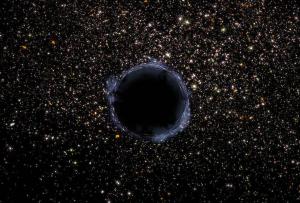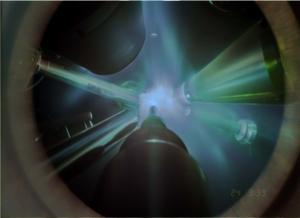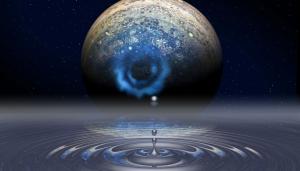LAB REPORT
Science and Technology Making Headlines
Oct. 19, 2018


LLNL’s George Chapline believes that black holes are really dark energy stars. Image courtesy of NASA
Do black holes exist?
Maybe not, according to Lawrence Livermore physicist George Chapline.
What does the supermassive black hole at the center of the Milky Way look like? Early next year, the Event Horizon Telescope — a virtual telescope with an effective diameter of the Earth — might show the world. It has been pointing at Sagittarius A* for the last several years. Most researchers in the astrophysics community expect that its images, taken from telescopes all over the Earth, will show the telltale signs of a black hole: a bright swirl of light, produced by a disc of gases trapped in the black hole’s orbit, surrounding a black shadow at the center — the event horizon.
However, Chapline doesn’t expect to see a black hole. He doesn’t believe they’re real. In 2005, he told Nature that “it’s a near certainty that black holes don’t exist” and — building on previous work he’d done with physics Nobel laureate Robert Laughlin — introduced an alternative model that he dubbed “dark energy stars.” Dark energy is a term physicists use to describe a peculiar kind of energy that appears to permeate the entire universe. It expands the fabric of spacetime itself, even as gravity attempts to bring objects closer together.


Texas has had a severe drought for the past several years. Climate scientists say more droughts and floods are to come for the Lone Star State.
Hot enough for you?
The United States has just come off a record year for weather and climate disasters and, by most accounts, it's only going to get worse.
Texas is particularly vulnerable to a changing climate. It has had more costly weather-related disasters than any other state, and those events will happen more often as air and ocean temperatures climb, scientists say. While uncertainty is built into climate models, scientists have a high degree of confidence in many of the changes they observe and predict. In fact, researchers have used models to predict global temperature changes for more than 50 years, and the models' projections have been fairly accurate over the long term. In the early 21st century, a discrepancy appeared between observed and modeled temperatures — a period dubbed the "global warming slowdown" or "hiatus."
Scientists have published scores of studies on the mismatch and tied it to several factors that contributed to lower-than-expected observed temperatures. Those factors include a series of small volcanic eruptions, the cooling effects of which scientists had underestimated, and lower than expected solar output.
Findings from those studies are helping to improve climate model simulations and helping scientists better understand why there are differences between simulations and observations in the early 21st century, said Ben Santer, a climate scientist at the Lawrence Livermore.


Compression experiments allow liquid water to be driven to an extremely undercooled state and nucleate a high-pressure polymorph known as ice VII. This unique phase of ice is believed to exist near the core of "ocean world” planets, recently detected by observation.
Under pressure
A team of theorists from Lawrence Livermore has solved a long-standing puzzle in the nucleation of a high-pressure phase of ice known as ice VII, which is believed to exist near the core of “ocean world” planets recently detected outside of the solar system and may exist within Earth’s mantle.
Water has been found to freeze into ice VII in laboratory experiments that use shock or ramp waves to compress liquid water to pressures exceeding 100,000 times that found at ambient conditions. However, experiments conducted by different research groups have presented contradictory modes. In one case, ice forms on a nearby material surface but in other studies ice was found to form within the bulk of the water sample and with a much faster rate of crystallization, with the entire sample frozen in an astoundingly short timescale of 10 nanoseconds.
“The conditions created by shock compression are unusual in that they produce an enormous driving force for the system to nucleate — there are unique considerations that need to be taken into account for solidification at high pressure,” said Philip Myint, a staff member in the Physics Division at LLNL.
The team found that this transient nucleation mechanism has a profound effect on the timescale for crystallization, an insight that alters how high-pressure experiments might be conducted in the future.


UCSD recently was named a center of excellence for Matters under Extreme Pressure. Lawrence Livermore is one of the partners in the center.
Center for excellence
The University of California San Diego was awarded $10.5 million over five years from the National Nuclear Security Administration (NNSA) to create one of four new centers of excellence. The Center for Matters under Extreme Pressure (CMEC) will be the third NNSA center focused on high energy density science.
The center will be headquartered at UC San Diego but will work in partnership with three other UC campuses — Berkeley, Davis and Los Angeles — the University of Chicago, Florida A&M University and General Atomics. Additionally, they will work in close collaboration with four Department of Energy national laboratories: Lawrence Livermore, Sandia, Los Alamos and SLAC National Accelerator.
High energy density science deals with matter under extreme conditions of temperature and pressure, such as those that exist in the interior of stars and planets. At such extreme pressure — 1 million to 1 trillion times the atmospheric pressure on the Earth's surface — matter behaves differently than under normal conditions on Earth. The fundamental challenge is to understand the underlying physical processes required to predict and control material properties in these extreme environments.
The center will be a part of NNSA's Stockpile Stewardship Academic Alliances, created to support scientific advancement, promote interactions between academia and NNSA labs and train scientists in relevant areas of research.


Unraveling the properties of fluid metallic hydrogen at the National Ignition Facility could help scientists unlock the mysteries of Jupiter’s formation and internal structure. Credit: Mark Meamber/LLNL
Diving into gas giants
With gentle pulses from gigantic lasers, scientists at Lawrence Livermore transformed hydrogen into droplets of shiny liquid metal. Their research could improve the understanding of giant gas planets like Jupiter and Saturn, whose interiors are believed to be awash with liquid metallic hydrogen.
On Earth, hydrogen's behavior is straightforward. But Jupiter isn’t Earth, and the hydrogen found in abundance within and beneath the great bands and swirling storms of its atmosphere can be pushed beyond its normal limits.
The conditions in which hydrogen disassociates and becomes an atomic metal occur in high energy density environments, such as the interiors of giant planets and nuclear explosions. LLNL scientists directed 168 lasers on deuterium samples at the National Ignition Facility to measure the pressure and temperature conditions of the hydrogen transition.





